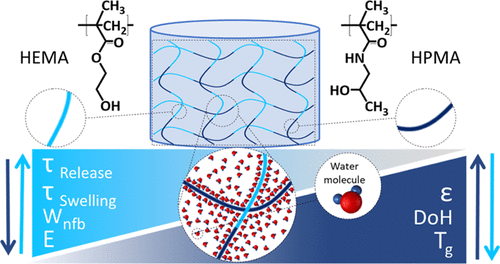当前位置:
X-MOL 学术
›
ACS Biomater. Sci. Eng.
›
论文详情
Our official English website, www.x-mol.net, welcomes your
feedback! (Note: you will need to create a separate account there.)
Biotechnical Properties of Poly(HEMA-co-HPMA) Hydrogels Are Governed by Distribution among Water States
ACS Biomaterials Science & Engineering ( IF 5.4 ) Pub Date : 2019-09-25 , DOI: 10.1021/acsbiomaterials.9b00705 Sara Abasi 1 , Daria Anna Podstawczyk 1, 2 , Alycia Farida Sherback 1 , Anthony Guiseppi-Elie 1, 2, 3
ACS Biomaterials Science & Engineering ( IF 5.4 ) Pub Date : 2019-09-25 , DOI: 10.1021/acsbiomaterials.9b00705 Sara Abasi 1 , Daria Anna Podstawczyk 1, 2 , Alycia Farida Sherback 1 , Anthony Guiseppi-Elie 1, 2, 3
Affiliation

|
Controlling the biotechnical properties of synthetic hydrogels allows their application in a wide range of biomedical fields. Cross-linker concentration and monomer mole ratio of poly(2-hydroxyethylmethacrylate-co-N-(2-hydroxypropyl) methacrylamide) [poly(HEMA-co-HPMA)]-based hydrogels were used to control the degree of hydration and water distribution within constructs. Cross-linker concentrations corresponding to 0.1, 0.5, 1.0, and 3.0 mol % tetraethylene glycol (TEGDA) with HEMA/HPMA mole ratios of 1:0 and 4:1, and poly(HEMA-co-HPMA) of cross-linker concentration corresponding to 1.0 mol % TEGDA with a HEMA/HPMA ratio of 1:1 were investigated for their degree of hydration, water distribution, and corresponding physiochemical and mechanical properties. Copolymerization of HEMA and HPMA was confirmed by Fourier-transform infrared spectroscopy. Both cross-linker concentration and chemical composition (HEMA/HPMA) systematically changed the water content and free/bound water distribution in the polymer, which resulted in different biochemical and transport properties. The addition of 20% HPMA (poly(HEMA-co-HPMA) (4:1)) increased total hydration (25%) and glass-transition temperature (9%) and decreased elastic modulus (31%) and nonfreezable bound water (33%) of the hydrogel. Increasing cross-linker concentration resulted in a stiffer hydrogel with less total water but larger nonfreezable water content. Evaluation of poly(HEMA-co-HPMA) (1:1) revealed that further increase of HPMA content increased the degree of hydration by 25% and decreased nonfreezable water content and elastic modulus by 33 and 16%, respectively, compared to that of poly(HEMA-co-HPMA) (4:1). The hydrogel correspondingly had a higher void fraction and rougher freeze-fractured surface. The diffusion-related processes depended more on water distribution within the hydrogel. The poly(HEMA) showed the fastest swelling kinetics with a concomitant burst release profile of fluorescein isothiocyanate–dextran (a drug surrogate), while the compositions containing HPMA showed a sustained release pattern. The biotechnical properties are illustrative examples of key properties that are influenced by the water distribution rather than the absolute water content of hydrogels.
中文翻译:

聚(HEMA-共-HPMA)水凝胶的生物技术特性受水态分布的支配
控制合成水凝胶的生物技术特性使其可以在广泛的生物医学领域中应用。交联剂浓度和聚单体的摩尔比(2- hydroxyethylmethacrylate-共- ñ - (2-羟丙基)甲基丙烯酰胺)[聚(HEMA-共-HPMA)] -基于水凝胶用于控制水合的水和分布程度在构造内。交联剂浓度对应于0.1、0.5、1.0和3.0摩尔%的四乙二醇(TEGDA),HEMA / HPMA摩尔比为1:0和4:1,而聚(HEMA- co研究了HEMA / HPMA比为1:1的交联剂浓度(对应于1.0 mol%TEGDA)的水合度,水分布以及相应的理化和机械性能。HEMA和HPMA的共聚通过傅里叶变换红外光谱法确认。交联剂浓度和化学组成(HEMA / HPMA)均系统地改变了聚合物中的水含量和自由/结合水分布,从而导致了不同的生化和运输特性。添加20%HPMA(poly(HEMA- co-HPMA)(4:1))增加了水凝胶的总水合(25%)和玻璃化转变温度(9%),并降低了弹性模量(31%)和不可冻结的结合水(33%)。交联剂浓度的增加导致水凝胶变硬,总水量减少,但不可冻结的水含量增加。聚(HEMA- co- HPMA)(1:1)的评估表明,与HPEMA相比,HPMA含量的进一步增加分别使水合度提高了25%,并使不可冻结的水含量和弹性模量降低了33%和16%。聚(HEMA- co-HPMA)(4:1)。水凝胶相应地具有较高的空隙率和较粗糙的冷冻断裂表面。与扩散有关的过程更多地取决于水凝胶内的水分布。聚(HEMA)表现出最快的溶胀动力学,同时伴随着异硫氰酸荧光素-葡聚糖(一种药物替代品)的爆发释放特性,而含有HPMA的组合物则表现出持续释放的模式。生物技术性质是受水分布而不是水凝胶的绝对含水量影响的关键性质的说明性实例。
更新日期:2019-09-26
中文翻译:

聚(HEMA-共-HPMA)水凝胶的生物技术特性受水态分布的支配
控制合成水凝胶的生物技术特性使其可以在广泛的生物医学领域中应用。交联剂浓度和聚单体的摩尔比(2- hydroxyethylmethacrylate-共- ñ - (2-羟丙基)甲基丙烯酰胺)[聚(HEMA-共-HPMA)] -基于水凝胶用于控制水合的水和分布程度在构造内。交联剂浓度对应于0.1、0.5、1.0和3.0摩尔%的四乙二醇(TEGDA),HEMA / HPMA摩尔比为1:0和4:1,而聚(HEMA- co研究了HEMA / HPMA比为1:1的交联剂浓度(对应于1.0 mol%TEGDA)的水合度,水分布以及相应的理化和机械性能。HEMA和HPMA的共聚通过傅里叶变换红外光谱法确认。交联剂浓度和化学组成(HEMA / HPMA)均系统地改变了聚合物中的水含量和自由/结合水分布,从而导致了不同的生化和运输特性。添加20%HPMA(poly(HEMA- co-HPMA)(4:1))增加了水凝胶的总水合(25%)和玻璃化转变温度(9%),并降低了弹性模量(31%)和不可冻结的结合水(33%)。交联剂浓度的增加导致水凝胶变硬,总水量减少,但不可冻结的水含量增加。聚(HEMA- co- HPMA)(1:1)的评估表明,与HPEMA相比,HPMA含量的进一步增加分别使水合度提高了25%,并使不可冻结的水含量和弹性模量降低了33%和16%。聚(HEMA- co-HPMA)(4:1)。水凝胶相应地具有较高的空隙率和较粗糙的冷冻断裂表面。与扩散有关的过程更多地取决于水凝胶内的水分布。聚(HEMA)表现出最快的溶胀动力学,同时伴随着异硫氰酸荧光素-葡聚糖(一种药物替代品)的爆发释放特性,而含有HPMA的组合物则表现出持续释放的模式。生物技术性质是受水分布而不是水凝胶的绝对含水量影响的关键性质的说明性实例。































 京公网安备 11010802027423号
京公网安备 11010802027423号